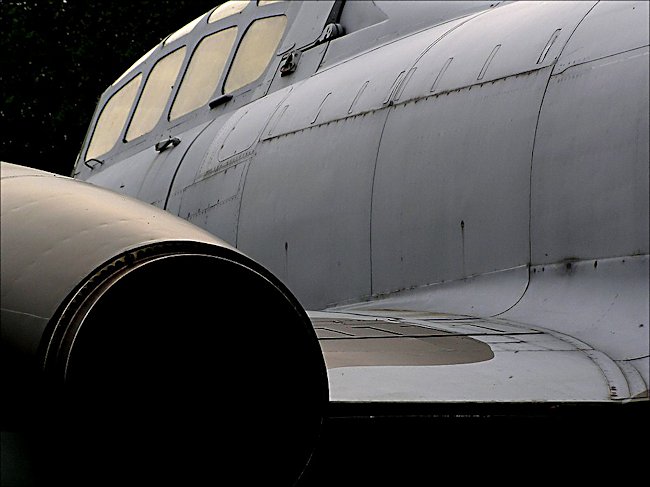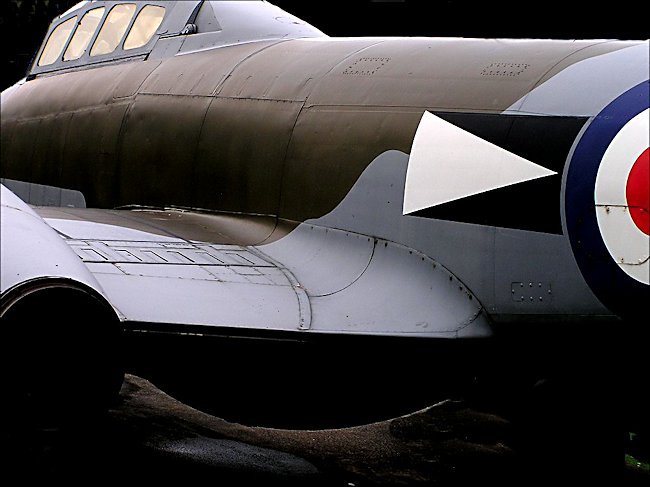RAF Gloucester Meteor Jet fighter
In 1940, the British Ministry of Defence - Air Ministry issued an order for a twin-engine jet. The Gloucester Meteor became the first jet aircraft to enter RAF service. It was introduced into service in August 1944, only a few weeks after the German Luftwaffe jet engine Messerschmitt ME 262 took to the skies over Germany
It eventually equipped the Air Forces of fourteen countries. In the RAF it replaced the aging wooden Mosquitos. Different versions of the Meteor remained in front-line service for many years and was used operationally as a night fighter by the RAF until 1954. The benefits of the engines being in the wings was that it made easier the design of armament incorporation and it reduces problems with effects of the slipstream on the rear tail components and fuselage.

RAF 616 Squadron's F1 Gloucester Meteors were replaced by F3 Gloucester Meteors when on 17 January 1945, they moved to RAF Colerne in Wiltshire. Meteors were forbidden to fly over enemy territory for "security reasons" but on 20th January 1945, four Meteors were sent to mainland Europe, although they were kept behind Allied lines. In March 1945 it was necessary to paint the planes all white to try and stop Allied forces firing at them. They were finally allowed to enter enemy territory 17th April 1945, but only two encounters took place with the German Luftwaffe. One was when a single Meteor encountered a German Fieseler Storch. It managed to land but was then destroyed by the Meteor on the ground. The other was a potential encounter with several German Luftwaffe Focke-Wulf 190s, which was cut short when some Spitfires and Hurricanes appeared on the scene. They opened fire on the Meteors thinking they were Messerschmitt 262s. No Meteors were shot down by enemy or allied forces during the war but there on 29th April 1945 two Meteors crashed in cloud over Germany. The Gloucester Meteor was used successfully as a ground-attack aircraft. Thirty Meteors saw war service. Armstrong Whitworth developed the 2 seat night fighter NF11
On 7th November 1945, Group Captain Willie Wilson in a Gloucester Meteor F4 broke the high speed record with a speed of 975.845 km / hour. The previous official record of 754.97 km / hr had stood since 1939 and had been frozen because of the war. The RAF High Speed Flight was re-formed, at RAF Tangmere with six Meteor F4s. A new world record of 990.971 km / hr was set 7th September flying over a three kilometre course between in Sussex. The High Speed Flight was disbanded on 26 September 1946 as further attempts to increase the speed with the Meteor were unsuccessful.
Gloucester Meteors were fitted with ejector sets. The first manned ejection occurred on 24 July 1946, when Bernard Lynch ejected from a Meteor T7 using a Martin-Baker ejection seat. Modified Meteors carried out successful carrier operations between April and June 1948.

During the Korean War the RAF had no fighters in the war zone on active patrol, but 77 Squadron of the Australian Air Force flew Gloucester Meteor T8s. The Squadron had be re-equipped with Meteor T8s from US P-51 Mustangs. The Meteor was no match for the Russian built MIGs but the RAAF could not get their hands on any USAF Sabres as they were all being brought into service USAF squadrons first. The Meteors operated in the war zone from 30th July 1951. There were a couple of disastrous encounters with Mig-15s before the RAAF officially recognized that the Meteors were outclassed.
The top brass then switched them to a ground-attack role in areas generally away from those inhabited by Migs. RAAF 77 Squadron lost 53 aircraft out of the 93 that were delivered. 32 Australian pilots were killed and only three North Korean Mig-15s were claimed shot down. Australian-built Sabres replaced the Meteors of 77 Squadron in 1955.
The Gloucester Meteor F8 was built in greater numbers than other variants. In the early 1950s the F8 became the RAF's premier front-line jet fighter but, by the time the F8 was introduced, the Meteor was past its prime as an interceptor. It was still effective as a ground-attack aircraft. In 1955, the Hunter began to replace Meteors as the RAF's interceptor but it was still on frontline war duty in Malaya that same year. It was still being flown in the RAF until August 1961. The Gloucester Meteor served with the RAF Squadrons No.'s 1, 41, 42, 56, 63, 66, 74, 91, 92, 124, 222, 234, 245, 257, 263, 500, 504, 600, 611, 615 and 616.
A team of four Meteor T7 aircraft part of the RAF Central Flying School's official display team were called "The Meteorites" during the 1952 and 1953 Air Show seasons. They were the first RAF display team to be given a name; until that time teams were known only by their squadron numbers. They were disbanded at the end of the 1953 season
This is a record of the Gloucester Meteor Variants. The prefix "F" stands for Fighter, "NF" stands for Night Fighter, "T" stands for trainer and "FR" stands for Fighter Reconnaissance aircraft. The Gloucester Meteor F1 entered RAF service towards the end of the war. Equipped with Rolls-Royce Welland engines, and the Gloucester Meteor F3 was powered by Derwent engines with 8.9kN thrust. Sliding canopies. Introduced into 616 Squadron on 18. December 1944. An F3 (EE416) was used for the first live airborne ejection in Britain on 24. July 1946. The nose section of EE416 is on display in the Science Museum. The Gloucester Meteor F4 was first flown on 17 May 1945, powered by the Derwent 5, which was actually a scaled-down version of the Nene engine. This was the first post-war variant. It had a pressurised cockpit, but no ejector seats. The thrust of the engine was 75% more than the original, and the rate of climb was nearly double that of previous variants. It entered RAF service in 1947. The Gloucester Meteor F8 was the last single-seat fighter version. It first flew on 12. October 1948 and entered the RAF service in December 1949. Ejection seats were fitted as standard now and it had a fully transparent cockpit canopy. It was powered by the Derwent 8 engines rated at 16.0kN. It was built in greater quantity than any other mark.
The Gloucester Meteor T7 Tandem trainer, appeared in 1948, based on the F4. The World's first dual-control jet trainer. The Gloucester Meteor FR5 crashed during its maiden flight in June 1949. Only one was ever built. The Gloucester Meteor FR9 Fighter-reconnaissance version, was the final single-seater version. The Gloucester Meteor PR10 Photo-reconnaissance version took over the role of reconnaissance from RAF Mosquitos. The Gloucester Meteor NF11 night fighters was intended as interim aircraft and was succeeded by the Javelin. It was a two man plane with a T7 cockpit but a F8 rear fuselage and tail assembly. The guns were moved from the fuselage to the wings. They were delivered to the RAF in late 1950, and they were fully withdrawn by August 1961. 338 were built for home use, 20 for export. One hundred Gloucester Meteor NF12s were built. Forty Gloucester Meteor NF13, the tropicalized version were built and only one hundred Gloucester Meteor NF14 were built. The NF 14 was far superior to the NF 12, having spring-tab ailerons and an auto stabiliser to improve directional stability (a problem with the other marks was a tendency to snake, which did not help gunnery). It also had the excellent bubble hood, and so was the preferred mount
One hundred Gloucester Meteor F4s were sold to Argentina in 1947. During the anti-Peron uprising in 1955, government pilots flew Gloucester Meteors against rebel forces, losing two. The Rebels captured three Meteors when they overran the city of Cordoba, and then used them against the Peron government. They had to use petrol because of the lack of aviation fuel. This resulted in one aircraft exploding when its engine overheated. The Meteor remained in service with Argentina until the late 1950s
From 1949 the Belgium Air Force flew 474 Gloucester Meteors aircraft of different marks mainly the F4, F8, NF11. Brazil received 70 Gloucester Meteors aircraft, F8 and T7 in 1952, which were paid for with 15,000 tons of raw cotton, because of Brazil's shortage of convertible currency. Denmark flew twenty F4s, nine T7s, twenty F8s and twenty NF11. Ecuador had twelve Gloucester Meteor FR9s. Egypt used its Gloucester Meteor F8s to attack Israeli positions in 1956, escorted by Mig-15s. Most were later destroyed on the ground and two in aerial combat). An NF13 attempted an attack on an RAF Valiant.
During the 1956 war Israeli Gloucester Meteors kept away from the Migs of the Egyptian Air Force. They provided close escort for bombers, Dassault Mysteres, and transport aircraft. Two Israeli F8s engaged four Egyptian Vampires, shooting one down. Two days later a further two Vampires were brought down by Israeli Gloucester Meteor F8s. In total 11 Gloucester Meteor F8s and 6 T7s went to Israel in 1956. Between 1954 and 1958 six Gloucester Meteors NF13s were purchased.
France ordered two F4s as engine test-beds and from 1952 had thirty two NF11s, fourteen T7, two NF13, and one NF14. France used its Gloucester Meteor NF11s in Algeria. The Dutch Airforce flew two hundred and forty one Gloucester Meteor. One hundred and fifty five of these F8s aircraft were built in the Holland under license by Fokker. The Swedish airforce purchased three Gloucester Meteor T7s, The Air Force of Syria also flew Meteors. The Gloucester Meteor never broke the sound barrier. Pilots were not supposed to exceed Mach .77 but with throttles wide open and diving most pilots believed they could read .85 on the machmeter.
In reality this was about .82 but the aircraft was at its aerodynamic limit and no amount of extra power would make it go any faster. Pilots said that it was as though the aircraft was gripped in a giant vice and being vigorously rattled about, then a wing would drop, but control was instantly regained by extending the airbrakes. Flown normally the Meteor was said to be a very pleasant aircraft to fly in and crew felt safe and secure. Some referred to as a "gentleman's aeroplane." With the introduction of the V bombers Gloucester Meteor were completely outclassed and were soon replaced.
Meteor Jet fighter books


Tweet